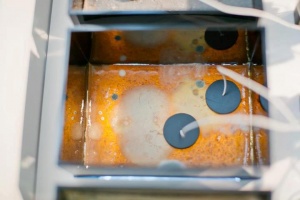Difference between revisions of "Mini-Mycophone, Ljubljana"
| Line 30: | Line 30: | ||
Mycelium (plural mycelia) is the vegetative part of a fungus, consisting of a mass of branching, thread-like hyphae. The mass of hyphae is sometimes called shiro, especially within the fairy ring fungi. Fungal colonies composed of mycelia are found in soil and on or within many other substrates. A typical single spore germinates into a homokaryotic mycelium, which cannot reproduce sexually; when two compatible homokaryotic mycelia join and form a dikaryotic mycelium, that mycelium may form fruiting bodies such as mushrooms. A mycelium may be minute, forming a colony that is too small to see, or it may be extensive, some call it the largest organism in the world. | Mycelium (plural mycelia) is the vegetative part of a fungus, consisting of a mass of branching, thread-like hyphae. The mass of hyphae is sometimes called shiro, especially within the fairy ring fungi. Fungal colonies composed of mycelia are found in soil and on or within many other substrates. A typical single spore germinates into a homokaryotic mycelium, which cannot reproduce sexually; when two compatible homokaryotic mycelia join and form a dikaryotic mycelium, that mycelium may form fruiting bodies such as mushrooms. A mycelium may be minute, forming a colony that is too small to see, or it may be extensive, some call it the largest organism in the world. | ||
| + | |||
| + | '''Agar''' | ||
| + | |||
| + | Agar or agar-agar is a gelatinous substance derived by boiling a polysaccharide in red algae, where it accumulates in the cell walls of agarophyte and serves as the primary structural support for the algae's cell walls.Agar is a mixture of two components: the linear polysaccharide agarose, and a heterogeneous mixture of smaller molecules called agaropectin. Throughout history into modern times, agar has been chiefly used as an ingredient in desserts throughout Asia and also as a solid substrate to contain culture medium for microbiological work. | ||
===Main Used Materials=== | ===Main Used Materials=== | ||
| Line 35: | Line 39: | ||
'''General Tools''' | '''General Tools''' | ||
| − | soldering iron, lab | + | soldering iron, lab equipment (Petri dishes, Bunsen burner, electrical stove) |
'''Sound System''' | '''Sound System''' | ||
| Line 43: | Line 47: | ||
'''Growth System''' | '''Growth System''' | ||
| − | agar, button mushrooms for growing the mycelium, coca-cola for mycelium food | + | agar, sawdust, button mushrooms for growing the mycelium, coca-cola for mycelium food |
'''Boxing System''' | '''Boxing System''' | ||
Revision as of 00:55, 1 April 2013
Workshops leaders:
Saša Spačal (SI)
Assistants:
Dr. Mirjan Švagelj, Kristjan Tkalec
Contents
Info for the LabBook
Pocket booklet with instructions for building MiniMycophone.
Workshop
MiniMycophone, biohacked music box
Authors: Saša Spačal, Dr. Mirjan Švagelj
Short Description aka Kratek opis
Delavnica predstavitve pomena gob v ekosistemu, gojenja gob in izgradnja bio-hakirane glasbene skrinjice - MiniMycophona.
Workshop about the importance of mushrooms in our ecosystem, their cultivation and building of biohacked music box - MiniMycophone.
Glossary
Mycelium
Mycelium (plural mycelia) is the vegetative part of a fungus, consisting of a mass of branching, thread-like hyphae. The mass of hyphae is sometimes called shiro, especially within the fairy ring fungi. Fungal colonies composed of mycelia are found in soil and on or within many other substrates. A typical single spore germinates into a homokaryotic mycelium, which cannot reproduce sexually; when two compatible homokaryotic mycelia join and form a dikaryotic mycelium, that mycelium may form fruiting bodies such as mushrooms. A mycelium may be minute, forming a colony that is too small to see, or it may be extensive, some call it the largest organism in the world.
Agar
Agar or agar-agar is a gelatinous substance derived by boiling a polysaccharide in red algae, where it accumulates in the cell walls of agarophyte and serves as the primary structural support for the algae's cell walls.Agar is a mixture of two components: the linear polysaccharide agarose, and a heterogeneous mixture of smaller molecules called agaropectin. Throughout history into modern times, agar has been chiefly used as an ingredient in desserts throughout Asia and also as a solid substrate to contain culture medium for microbiological work.
Main Used Materials
General Tools
soldering iron, lab equipment (Petri dishes, Bunsen burner, electrical stove)
Sound System
speakers, sound circuit, battery
Growth System
agar, sawdust, button mushrooms for growing the mycelium, coca-cola for mycelium food
Boxing System
forex
Target Participants
Age group: +14
Number of participants: 8 - 10
Interests: mushrooms, sound circuits, electronics, biohacking
Schedule
Date: Saturday, 20. April 2013
Duration: 5, 6 hours
Location
Biotehna, Ljubljana, Slovenia
